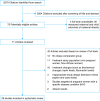Maternal obesity in Africa: a systematic review and meta-analysis
- PMID: 26487702
- PMCID: PMC5072166
- DOI: 10.1093/pubmed/fdv138
Maternal obesity in Africa: a systematic review and meta-analysis
Abstract
Background: Maternal obesity is emerging as a public health problem, recently highlighted together with maternal under-nutrition as a 'double burden', especially in African countries undergoing social and economic transition. This systematic review was conducted to investigate the current evidence on maternal obesity in Africa.
Methods: MEDLINE, EMBASE, Scopus, CINAHL and PsycINFO were searched (up to August 2014) and identified 29 studies. Prevalence, associations with socio-demographic factors, labour, child and maternal consequences of maternal obesity were assessed. Pooled risk ratios comparing obese and non-obese groups were calculated.
Results: Prevalence of maternal obesity across Africa ranged from 6.5 to 50.7%, with older and multiparous mothers more likely to be obese. Obese mothers had increased risks of adverse labour, child and maternal outcomes. However, non-obese mothers were more likely to have low-birthweight babies. The differences in measurement and timing of assessment of maternal obesity were found across studies. No studies were identified either on the knowledge or attitudes of pregnant women towards maternal obesity; or on interventions for obese pregnant women.
Conclusions: These results show that Africa's levels of maternal obesity are already having significant adverse effects. Culturally adaptable/sensitive interventions should be developed while monitoring to avoid undesired side effects.
Keywords: obesity; population-based and preventative services; pregnancy and childbirth disorders.
© The Author 2015. Published by Oxford University Press on behalf of Faculty of Public Health.
Figures
References
-
- Obesity and overweight-fact sheet [WWWdocument] http://www.who.int/mediacentre/factsheets/fs311/en/ (10 December 2012, date last accessed).
-
- Popkin BM. Part II. What is unique about the experience in lower- and middle-income less-industrialised countries compared with the very-high-income industrialised countries? The shift in stages of the nutrition transition in the developing world differs from past experiences. Public Health Nutr 2002;5 (1A):205–14. - PubMed
-
- Puhl RM, Heuer CA. The stigma of obesity: a review and update. Obesity 2009;17 (5):941–64. - PubMed
Publication types
MeSH terms
LinkOut - more resources
Full Text Sources
Other Literature Sources
Medical


